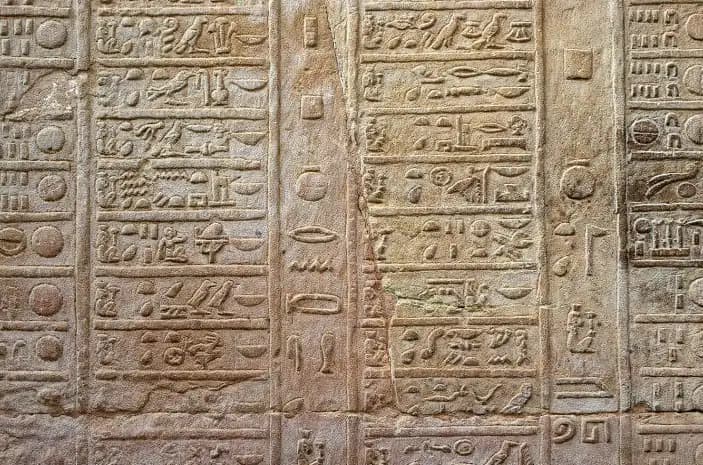
Step back in time and delve into the fascinating world of ancient Egyptian writing. Hieroglyphs, the pictorial script used by the ancient Egyptians, remains one of the most captivating forms of written communication in history. These mysterious symbols have intrigued scholars and the general public alike for centuries, offering a glimpse into the beliefs, culture, and daily life of this enigmatic civilization. From the Great Pyramids to the Valley of the Kings, hieroglyphs have left their mark across Egypt's ancient landscape. But how were these symbols deciphered, and what secrets do they reveal about this ancient civilization? Join us on a journey of discovery as we unlock the mystery of hieroglyphs and explore the rich history and culture of ancient Egypt. From the basics of the script to the latest breakthroughs in decipherment, this exploration promises to be an unforgettable adventure through the fascinating world of ancient Egyptian writing.
Hieroglyphs are one of the most iconic and recognizable aspects of ancient Egyptian culture. These intricate symbols were used by the ancient Egyptians for over 3,500 years and are considered to be one of the oldest writing systems in the world. In this essay, we will explore the history of hieroglyphs, their significance in ancient Egyptian society, and their legacy in modern times.
The origins of hieroglyphs can be traced back to the early Dynastic Period (c. 3100-2686 BCE) in ancient Egypt. At this time, the country was divided into two regions, Upper Egypt and Lower Egypt. Each region had its own hieroglyphic system, which was used to write in different dialects.
The hieroglyphs of Upper Egypt were based on pictures of animals, plants, and objects, while those of Lower Egypt were more abstract and geometric in nature. Over time, the two systems merged and became the standardized form of hieroglyphs that we are familiar with today.
Hieroglyphs were used for a variety of purposes, including religious, ceremonial, and everyday communication. The script was often used to decorate temples, tombs, and other important structures. Hieroglyphs were also used to record historical events, such as military campaigns and the reigns of pharaohs.
One of the primary functions of hieroglyphs was to convey religious and mythological concepts. Many hieroglyphic inscriptions describe the beliefs and rituals of the ancient Egyptians, as well as their relationships with the gods. Hieroglyphs were also used to record funerary texts, such as the Book of the Dead, which guided the deceased on their journey through the afterlife.
Hieroglyphs are a complex system of signs that include both pictorial and phonetic elements. The script is read from right to left, and the direction of the signs indicates the direction of the text. Hieroglyphs can be written in rows or columns, depending on the context.
Hieroglyphs are composed of three types of signs: phonetic signs, logograms, and determinatives. Phonetic signs represent sounds, while logograms represent words or concepts. Determinatives are signs that indicate the category or context of the word being written.
Phonetic signs are further divided into three categories: consonantal signs, vowel signs, and syllabic signs. Consonantal signs represent consonant sounds, while vowel signs represent vowel sounds. Syllabic signs represent a combination of consonant and vowel sounds.
Deciphering hieroglyphs was a long and difficult process that involved the work of many scholars over several centuries. The breakthrough came in 1799 with the discovery of the Rosetta Stone, a decree issued by King Ptolemy V in 196 BCE. The decree was written in three scripts: Greek, demotic, and hieroglyphs.
The Greek text provided the key to deciphering the hieroglyphs, as scholars were able to match the Greek words with the hieroglyphic signs. The decipherment of hieroglyphs was further aided by the work of scholars such as Jean-Francois Champollion, who used the Rosetta Stone and other inscriptions to develop a system for reading hieroglyphs.
Despite the progress made in deciphering hieroglyphs, many inscriptions remain undeciphered, and there is still much to learn about this ancient script.
The Rosetta Stone is perhaps the most famous hieroglyphic inscription in the world. The stone, which is housed in the British Museum, contains a decree issued by King Ptolemy V in 196 BCE. The decree is written in three scripts: Greek, demotic, and hieroglyphs. The Greek text provided the key to deciphering the hieroglyphs, and the stone played a crucial role in the decipherment of the script.
Another famous hieroglyphic inscription is the Book of the Dead, a collection of funerary texts that were buried with the deceased. The texts guided the deceased on their journey through the afterlife and included spells and incantations to protect the soul.
Hieroglyphs were a central aspect of ancient Egyptian culture and society. They were used for a wide variety of purposes, including religious texts, historical accounts, and administrative records.
One of the most important uses of hieroglyphs was in religious texts. The ancient Egyptians believed that hieroglyphs were a sacred gift from the gods and that they had the power to convey divine knowledge and wisdom.
Hieroglyphs were also used to record the achievements of the pharaohs and other important figures in society. The inscriptions on the walls of the pyramids at Giza, for example, describe the lives and accomplishments of the pharaohs who were buried there.
In addition, hieroglyphs were used for administrative purposes. They were used to keep track of taxes, land ownership, and other important matters of the state.
Despite the decline of hieroglyphs as a writing system, their legacy lives on in many ways. Here are some examples of how hieroglyphs continue to influence our world today:
Art and Design: Hieroglyphs are considered to be one of the most beautiful and intricate writing systems in the world. They continue to inspire artists and designers, who use hieroglyphs as a source of inspiration for their work. For example, many fashion designers have used hieroglyphs in their designs, incorporating them into clothing, jewelry, and accessories.
Education and Research: Hieroglyphs remain an important source of information about ancient Egyptian culture, religion, and history. They provide valuable insights into the beliefs, practices, and achievements of one of the world's most fascinating civilizations. Today, hieroglyphs are studied by scholars and researchers in many fields, including Egyptology, linguistics, and history.
Pop Culture: Hieroglyphs have been featured in countless movies, TV shows, and video games over the years. They are often used to create a sense of mystery and intrigue or to evoke the ancient and exotic world of ancient Egypt. Some popular examples of hieroglyphs in pop culture include the movie "The Mummy," the video game "Assassin's Creed Origins," and the TV show "Stargate SG-1."
Tourism: The ancient monuments and artifacts of Egypt, many of which are covered in hieroglyphs, continue to draw tourists from all over the world. Visitors can see hieroglyphs in person at the pyramids of Giza, the temples of Luxor and Karnak, and many other historic sites throughout the country.
Digital Technology: With the advent of digital technology, hieroglyphs have become more accessible than ever before. Today, it is possible to view and study hieroglyphs online, using tools such as virtual tours, digital archives, and online courses. This has opened up new opportunities for people to learn about and appreciate the beauty and significance of hieroglyphs.
Hieroglyphs were used for over 3,000 years.
The script was used to write on a variety of surfaces, including papyrus, stone, and pottery.
There are over 700 different hieroglyphs in the script.
Hieroglyphs were often written in a decorative style, with the signs arranged in artistic and symmetrical patterns.
The earliest known example of hieroglyphs is a pottery vessel from the Nagada II period.
Hieroglyphs remain one of the most fascinating forms of written communication in history. From their use in religious and ceremonial contexts to their role in recording historical events and daily life, hieroglyphs offer a glimpse into the beliefs and culture of the ancient Egyptians. While the decipherment of hieroglyphs was a long and challenging process, the script continues to capture the imagination of people around the world. Whether you are a scholar, a history buff, or simply curious about this ancient script, the study of hieroglyphs promises to be a fascinating and rewarding journey of discovery.
“In my opinion, I believe a good writer makes content easy to read, and entertains the reader, making comprehension effortless. Egypt is a country that truly has it all. Its rich history, stunning landscapes, and friendly people make it a must-visit destination for any traveler. I hope you'll have the opportunity to experience it for yourself.
By Egypt Travel Blogger
Indulge in luxury aboard the MS Mayfair Nile cruise between Luxor and Aswan. Book now an amazing Nile Cruise vacation. ...
$ 799 | Per Person

Enjoy luxurious accommodation while sailing the Nile River between Luxor and Aswan aboard MS Farah nile cruise. Book Tod ...
$ 799 | Per Person